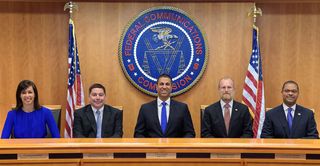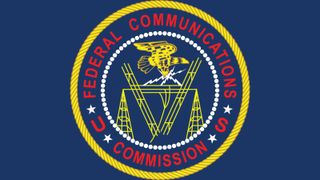FCC Votes to Sunset EBS Band Designation


A politically divided FCC has voted to convert the 2.5 GHz band from one reserved for educational (EBS) licenses to flexible licenses that can be used for 5G, and to auction current unassigned spectrum (white spaces) in the band.
Republicans backed the plan, while Democrats saw it as sacrificing a change to close the homework gap to handing over more spectrum to commercial companies that already control most of that spectrum via leases from educational and noncommercial license holders.
Related: FCC to Free Up 2.5 GHZ for 5G
The item "eliminates restrictions on the types of entities that can hold licenses as well as educational use requirements, while preserving incumbent licensees’ private contractual arrangements and provisions in existing leases. Further, the Order removes limitations on leases entered into on a going-forward basis under the Commission’s secondary markets rules, which will create incentives to build out in rural areas."
The Democrats saw the sunsetting of the EBS-controlled band as an abdication of an important educational mission, and strongly dissented on that part of the item. The Republicans said they were putting dramatically underused spectrum to its highest, best use--5G--and reforms "arcane" rules.
One thing the Democrats did support was giving tribal communities a priority window to obtain unassigned spectrum to serve tribal lands--the only part they approved. But the item does not include priority windows for incumbent educational users to get access to the currently unassigned spectrum. It does have a bidding credit for smaller entities, however.
FCC chair Ajit Pai pointed out that it has been 14 months since the 2.5 GHz proceeding, but that only yesterday one of his colleagues--commissioner Jessica Rosenworcel--had suggested the FCC hold an incentive auction for the spectrum (with the proceeds going to close the "homework" gap). "I believe that we need to make it a priority to auction mid-band airwaves right now—not in several years’ time—and accordingly, I am not willing to support such a delay," said Pai.
Broadcasting & Cable Newsletter
The smarter way to stay on top of broadcasting and cable industry. Sign up below
Pai pointed out the Rosenworcel has been calling for freeing up more midband spectrum ASAP, as she did again at the meeting, which is what is 2.5 GHz proposal does. Pai did not call out Rosenworcel by name, but it was clear who he was talking to in his statement on another 5G item the FCC voted on, rules for an auction of high-band spectrum (the upper 37 GHz, 39 GHz, and 47 GHz spectrum bands), which Rosenworcel said should not have been the FCC's focus given the need for midband.
"It is equal parts ironic and amusing that some continue to claim that we’re doing too little to free up mid-band spectrum, but then oppose every single initiative we’ve undertaken to do just that," he said. " You can’t demand action on mid-band spectrum and then oppose rules that make it possible to deploy 5G in the 3.5 GHz band. You can’t demand action on mid-band spectrum and then take the position that we must wait for Congress to act before we move forward on the C-band. And you can’t demand action on mid-band spectrum and then vote against an auction next year that would make 2.5 GHz spectrum available for commercial use. Or rather, you can do all of these things—but then the inescapable inference is that your real commitment is to political gamesmanship, not actual progress on mid-band spectrum."
In her statement on the 2.5 GHz item, Rosenworcel made a pitch for the incentive auction, saying it could get flexible use licenses to the market while funding digital age solutions for educational broadcasting. In her statement for the high-band auction rules, she said: "Our back of the pack approach to mid-band spectrum is leading us down the wrong road in the race to 5G. We need to change course stat."
"The Order frees the spectrum from the misguided choices of FCCs past," said commissioner Brendan Carr of the EBS order. "It makes the licenses flexible-use, which technology and the market show us will power 5G. It modernizes the licenses’ shapes by auctioning the white spaces and encouraging geographic consolidation. And it relies on market forces—rather than a protracted or reticulated FCC process—to quickly and fully rationalize the spectrum for 5G. This means mid-band for 5G today."
"Now, some will tell you that we shouldn’t take these steps to free up mid-band spectrum. They say this spectrum is for kids and schools. They pit winning the race to 5G against education, creating the illusion of a binary choice. But when you scratch the surface of their claim and see what’s underneath it, I can tell you it’s not the kids."
Both Carr and Pai pointed out that most of the EBS spectrum is controlled by commercial entities via leases, though Carr pointed out that was because the Reagan Administration favored that approach.
Carr also echoed his concerns, expressed earlier this week, that some of the nonprofits who also qualify for the EBS licenses were not using them for educational purposes, but pocketing the money or using it for political purposes.
"I am glad my colleagues agreed to include language in today’s decision that directs the Enforcement Bureau and the Wireless Telecommunications Bureau to review these existing license holders for compliance with our rules and other applicable laws," he said. Given that the item allows those nonprofits to sell their licenses, potentially at great profit, he said the FCC needs to make sure the auction resources "should go to kids and schools, not shady middlemen, not rent-seekers, and not scam artists."
Rosenworcel said not holding an incentive auction was a missed opportunity. "This order turns its back on the schools and educational institutions that have made the 2.5 GHz band their home since 1962," she said. "Today the FCC takes the innovative effort to infuse this band with learning opportunities—an initiative that dates back to the Kennedy Administration—and reverts to uninspired and stale commercial spectrum policy."
Contributing editor John Eggerton has been an editor and/or writer on media regulation, legislation and policy for over four decades, including covering the FCC, FTC, Congress, the major media trade associations, and the federal courts. In addition to Multichannel News and Broadcasting + Cable, his work has appeared in Radio World, TV Technology, TV Fax, This Week in Consumer Electronics, Variety and the Encyclopedia Britannica.

